|
HOME: www.hiltonpond.org |
|||
|
THIS WEEK at HILTON POND 22-30 June 2011 Installment #515---Visitor # (Back to Preceding Week; on to Next Week) |
|
MIDSUMMER SAMPLER 2011
When the end of June approaches at Hilton Pond Center things always appear to drop to lower gear in the world of nature. For example, some resident adult birds are starting their annual molt and with less than a full complement of feathers they fly a little less efficiently; thus, some species are even more secretive than usual. (This relative inactivity is offset somewhat by the antics of ever-hungry "big-baby" fledglings that follow their parents around begging for food.) Among local wildflowers most of the plentiful spring bloomers have completed their annual show, while plants that flower in mid-summer are not yet showing their stuff. Insects are becoming more numerous, of course, and with plentiful rains during the past month we may get a mosquito bite or two--but only when standing still to extricate birds from mist nets. Despite the seeming slow-down there's really still plenty happening outdoors at the Center, so this last week in June we sallied forth with camera, lens, and tripod for Midsummer Sampler 2001--a collection of things to be seen on our 11 acres. Regardless of when spring actually ended and summer began, it's been hot enough this year in the Carolina Piedmont that it already feels like midsummer.
All text, charts & photos © Hilton Pond Center One of our big nature disappointments this year occurred in conjunction with that much-publicized emergence of Brood 19 of the 13-Year Periodical Cicada, Magicicada spp. During summer the air around Hilton Pond Center is filled with sounds of Dog-day Cicadas, Tibicen spp., but these creatures occur annually and we were eager to experience the arrival of a less common variety that shows up in these parts only every 13 years. We also wanted a photo of one of these red-eyed cicadas for comparison to the black-eyed ones we see regularly. Alas, try as we might we never even heard a Periodical Cicada at the Center and the closest we came to finding one was beside the back deck--where we spotted a pair of cicada wings attached to a beaten-up thorax rolling along the ground in a light breeze (above).
All text, charts & photos © Hilton Pond Center In a way it was good the specimen was incomplete because it forced us to concentrate on just the cicada's flight apparatus. Made of ultra-thin membranous material, the four wings--one long pair and one pair short--were transparent with intricate orange-colored veins (above). Cicadas are not the most aerobatic of insects, but their stiff, amazingly tough wings get them from one tree to the next just fine during spring courtship. We're guessing the wing remains we found were dropped by something like a predatory Blue Jay whose heavy bill could handle a cicada and tear off the two-inch insect's head and abdomen. Although it was nice to see this incomplete artifact, we hope for a live specimen or two when Brood 19 of the 13-Year Periodical Cicada emerges again in 2024.
All text, charts & photos © Hilton Pond Center The Periodical Cicada, with its needle-like proboscis, is adapted for sucking sap from plants but there are plenty of other invertebrates that have chewing mouthparts. This is especially true of insect larval stages such as caterpillars, whose ravenous appetites often lead them to wreak havoc on leaf blades of various trees, shrubs, vines, and herbaceous plants at Hilton Pond Center. Such was the case this week with several Hazel Alders, Alnus serrulata, growing along the pond margin. On many of the shrubs' four-inch leaves, 50% or more of the blades had been nibbled away by insect herbivores (above). We examined the plants very closely but never could find any foliovores; we suspect the hungry larvae eat by night and hide from predators and curious naturalists during daylight hours. Although such heavy damage undoubtedly diminishes the alder's ability to photosynthesize, the shrub will make numerous new leaves per twig during the growing season and may be able to stay ahead of successive crops of insect larvae--especially if hungry birds help keep the caterpillars at bay.
All text, charts & photos © Hilton Pond Center Back in the summer of 1982 we had just returned from grad school in Minnesota to take up residence at what is now Hilton Pond Center. Even as we were unloading the moving van we set up a few corn-baited traps around the old farmhouse and on 28 June 1982 captured what became the Center's first banded bird--a female Common Grackle (like the one above) with a brood patch that indicated she was a local breeder. This week we celebrated our 29th anniversary of that banding and noted we've handled another 899 grackles in the years since--only one of which was reported elsewhere (found dead three years after banding near Charlotte NC). Over our nearly three decades of work around Hilton Pond, Common Grackles are our 11th most commonly banded species. All text, charts & photos © Hilton Pond Center Click on chart above to open a larger version in a new browser window We ended up with 21 Common Grackles (COGR) in 1982--our first "half year" of banding (see chart above)--but the following year caught a whopping 164 (mostly recent fledglings). That's still our all-time high for a 12-month period. Despite such a fast start we've banded an average of just 30 COGR per annum beginning with 1982, and only in two other years (1984 and 2002) caught more than 100. In fact, the red trend line on the chart indicates a real downhill slide for COGR banding at the Center--no doubt in large part because our once-open grassland attractive to foraging grackles is now nearly covered by dense young woodland. Even our pond margins, formerly frequented frog- and crayfish-loving grackles, are shrouded by shrubs and other vegetation and have become more difficult for birds to access.
All text, charts & photos © Hilton Pond Center Another factor that certainly contributed to our significant reduction in banded COGR is a neighboring 70-acre Loblolly Pine plantation that was clear-cut in early 1996 (see aerial photo above), depriving "our" blackbirds of nearby places to roost and nest. Two other things worth noting about the COGR chart: 1) The first half of the 1990s might have been more productive for catching grackles partly because we ran more nets then than we do today; and, 2) In our most recent big grackle year (2002), 129 of 132 COGR were banded on just two days (3-4 January) during a major snowstorm that brought big flocks of birds to our feeders and traps. That's one reason why come winter we always have an eye to the weather and our traps at the ready, ever hopeful a blanket of white stuff will bring in a bumper crop of Common Grackles that remind us of that first bird captured at Hilton Pond Center.
All text, charts & photos © Hilton Pond Center Young birds-of-the-year are indeed out and about this week at Hilton Pond Center, with Northern Cardinals among the most noticeable. By now fledglings of the Avian Class of 2011 are molting plumage they bore when they left the nest, and immature males show a mix of brownish juvenal feathers and the bright red feathers of an "adult." A young male's mandibles (above) are still somewhat dark--they turn a uniform bright orange in healthy adults--and his mask and mature crest are just starting to come in. Although our midsummer offerings of sunflower seeds and corn are taken by cardinals of all ages, the gooey purple mess on the lower mandible of the immature bird above is pretty good evidence he's been chowing down on abundant Wild Cherries ripening these days at the Center.
All text, charts & photos © Hilton Pond Center One third-year male Northern Cardinal at our feeders this week looked quite a bit different from the others in that he's lost most of his facial feathers (above). There's considerable debate over what's happening with this adult bird and others that look like what we call "lizard-heads." Some folks say this is a "normal" molt pattern exhibited by some cardinals and a few other avian species; we contend temporary baldness in these birds is caused by follicle mites that make feathers fall out simultaneously. We just don't believe a loss of all or most head plumage at the same time is adaptive for a bird.
All text, charts & photos © Hilton Pond Center With all the recent rain, we're not surprised to find lots of mushrooms erupting overnight at Hilton Pond Center. There's plenty of old organic stuff in the ground--one benefit of "losing" our garden rake and letting dead leaves and branches lie--and the subterranean mycelia of various fungi are hard at work decomposing the vegetable matter. We discovered the little unidentified mushroom above--only two inches tall--pushing up through a bed of moss and leaf litter. Such mechanical growth processes further enhance the soil by loosening and aerating it, all the better for seeds and roots of higher plants to prosper. Within 24 hours the mushroom had opened its cap all the way and begun to scatter millions of spores on the woodland floor, a guarantee there will be even more fungi in the not-too-distant future.
All text, charts & photos © Hilton Pond Center As always, native Trumpet Creeper--that 4" orange tubular flower we tout far and near as the quintessential hummingbird nectar vine--is blooming prolifically this June at Hilton Pond Center. Yes, even though the natural world seems to have slowed a little after the frenetic hustle and bustle of spring, an abundance of everything from birds to fungi and insects to wildflowers indicates a lot is still going on at Hilton Pond Center in late June, and all these organisms provide ample subjects for our Midsummer Sampler 2001. All text, charts & photos © Hilton Pond Center |
 The Piedmont Naturalist, Volume 1 (1986)--long out-of-print--has been re-published by author Bill Hilton Jr. as an e-Book downloadable to read on your iPad, iPhone, Nook, Kindle, or desktop computer. Click on the image at left for information about ordering. All proceeds benefit education, research, and conservation work of Hilton Pond Center for Piedmont Natural History. The Piedmont Naturalist, Volume 1 (1986)--long out-of-print--has been re-published by author Bill Hilton Jr. as an e-Book downloadable to read on your iPad, iPhone, Nook, Kindle, or desktop computer. Click on the image at left for information about ordering. All proceeds benefit education, research, and conservation work of Hilton Pond Center for Piedmont Natural History. |
|
|
"This Week at Hilton Pond" is written and photographed by Bill Hilton Jr., executive director of Hilton Pond Center for Piedmont Natural History
|
|
|
If you Twitter, please refer
"This Week at Hilton Pond" to followers by clicking on this button: Tweet Follow us on Twitter: @hiltonpond |
Comments or questions about this week's installment? Send an E-mail to INFO. (Be sure to scroll down for a tally of birds banded/recaptured during the period, plus other nature notes.) |
|
--SEARCH OUR SITE-- For a free on-line subscription to "This Week at Hilton Pond," send us an |
|
Thanks to the following fine folks for recent gifts in support of Hilton Pond Center for Piedmont Natural History and/or Operation RubyThroat: The Hummingbird Project. Your tax-deductible contributions allow us to continue writing, photographing, and sharing "This Week at Hilton Pond." Please see Support if you'd like to make a gift of your own.
|
|
Make credit card donations
on-line via Network for Good: |
|
|
Use your PayPal account
to make direct donations: |
|
|
If you like shopping on-line please become a member of iGive, through which 800+ on-line stores from Amazon to Lands' End and even iTunes donate a percentage of your purchase price to support Hilton Pond Center .
 Every new member who registers with iGive and makes a purchase earns an ADDITIONAL $5 for the Center. You can even do Web searches through iGive and earn a penny per search--sometimes TWO--for the cause! Please enroll by going to the iGive Web site. It's a painless, important way for YOU to support our on-going work in conservation, education, and research. Add the iGive Toolbar to your browser and register Operation RubyThroat as your preferred charity to make it even easier to help Hilton Pond Center when you shop. Every new member who registers with iGive and makes a purchase earns an ADDITIONAL $5 for the Center. You can even do Web searches through iGive and earn a penny per search--sometimes TWO--for the cause! Please enroll by going to the iGive Web site. It's a painless, important way for YOU to support our on-going work in conservation, education, and research. Add the iGive Toolbar to your browser and register Operation RubyThroat as your preferred charity to make it even easier to help Hilton Pond Center when you shop. |
|
|
SPECIES BANDED THIS WEEK: * = New species for 2011 WEEKLY BANDING TOTAL 12 species 42 individuals 2011 BANDING TOTAL 26 species 1,559 individuals 5 Ruby-throated Hummingbirds 30-YEAR BANDING GRAND TOTAL (since 28 June 1982, during which time 170 species have been observed on or over the property) 125 species (30-yr avg = 67.0) 56,436 individuals (30-yr avg = 1,881) NOTABLE RECAPTURES THIS WEEK (with original banding date, sex, and current age): Eastern Towhee (1) 09/13/10--2nd year female Northern Cardinal (1) House Finch (3) |
OTHER NATURE NOTES:
All text & photos © Hilton Pond Center --If page hits are any indication, LOTS of people have observed bald Northern Cardinals (see photo essay above) and then went to Google to learn more. The Internet search engine leads them straight to the Hilton Pond Center Web site and our extensive discussion of the phenomenon. Amazingly, of our 515 photo essays posted to date under "This Week at Hilton Pond," the one about Lizard-Heads is the fourth most visited with a total of 33,232 visitors since it was first published on-line in early Jul 2003. |


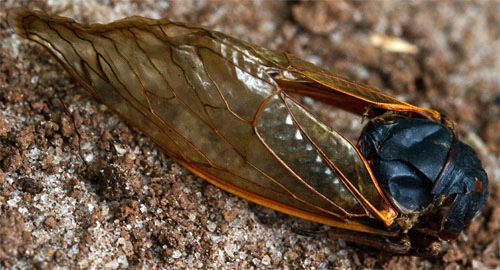
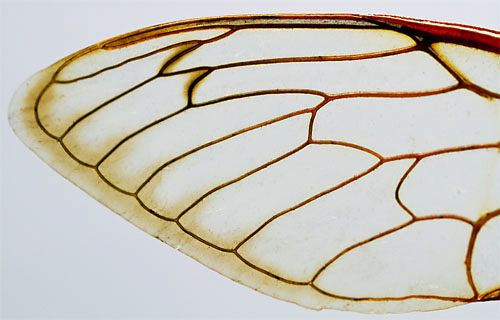
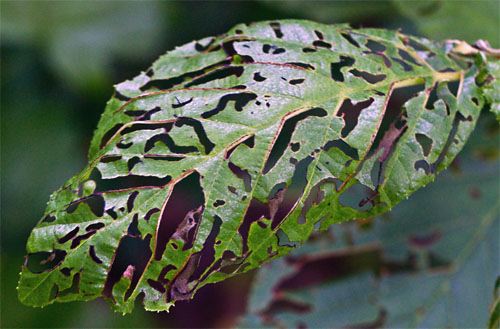

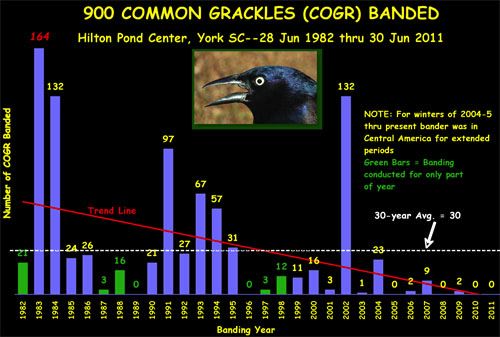


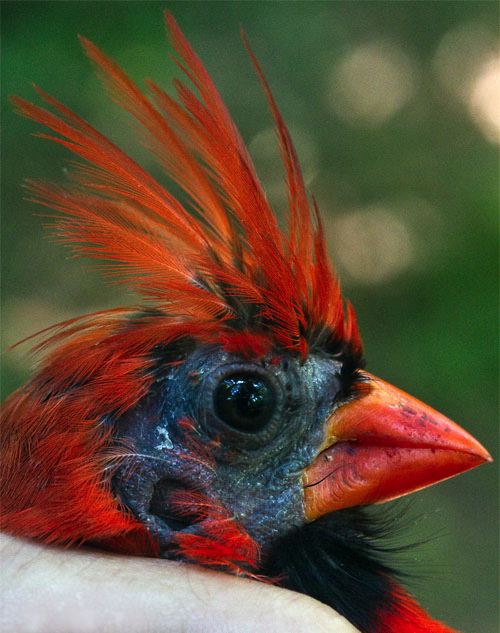
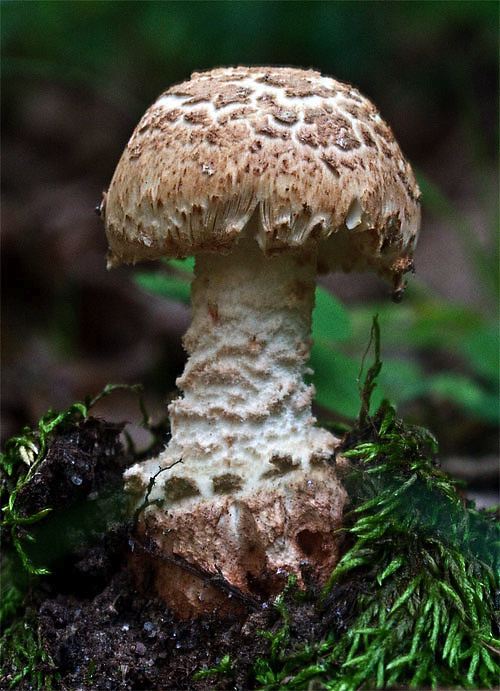
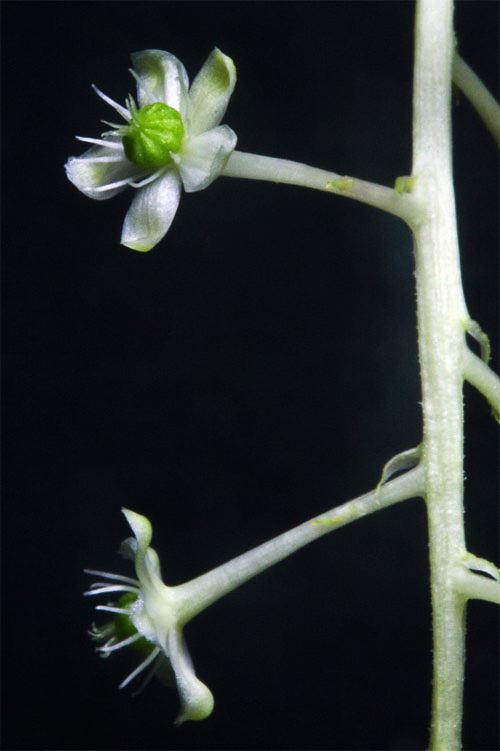
 Otherwise, we haven't many midsummer blossoms aside from Self-heal, English Ivy, Rose-of-Sharon, and Wild Petunia (right). There are also some rather robust, big-leaved weedy plants with branching five-foot-tall red stems and four-inch racemes bearing greenish-white inflorescence--our wordy description for Pokeweed, Phytolacca americana (above). Flowers of this native perennial soon will give rise to a cluster of purple-black berries relished by a wide variety of birds. We know this because by next month everything from Gray Catbirds to Yellow-breasted Chats (below left) will have faces and vents marked with purplish Pokeweed pigmentation--
Otherwise, we haven't many midsummer blossoms aside from Self-heal, English Ivy, Rose-of-Sharon, and Wild Petunia (right). There are also some rather robust, big-leaved weedy plants with branching five-foot-tall red stems and four-inch racemes bearing greenish-white inflorescence--our wordy description for Pokeweed, Phytolacca americana (above). Flowers of this native perennial soon will give rise to a cluster of purple-black berries relished by a wide variety of birds. We know this because by next month everything from Gray Catbirds to Yellow-breasted Chats (below left) will have faces and vents marked with purplish Pokeweed pigmentation--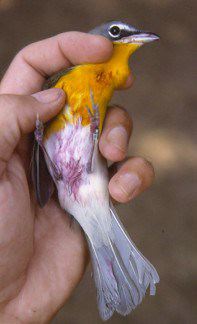 a stain that likewise shows up on our hands, clothing, and data sheets as we handle these birds for banding.
a stain that likewise shows up on our hands, clothing, and data sheets as we handle these birds for banding.
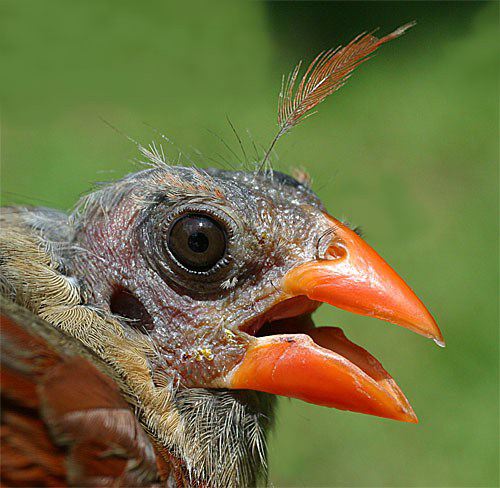
 Please report your
Please report your